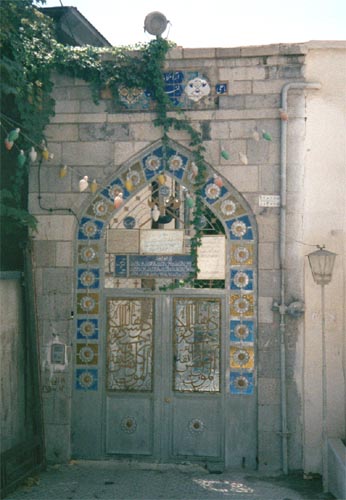
Sept. 21, 2005, Daily Times (Reuters)
Iran's Sufi beat lures dervishes and uptown girls
By Christian Oliver
The Sufis' mystical path to God through dance and music does not go down well with some of the most senior religious figures in Iran
TEHRAN: Venerable white-bearded dervishes and high-heeled girls with garish lipstick found rare common ground before dawn on Tuesday, celebrating an Iranian holiday with the mystical chants of the Sufis.
Sufi Muslim spirituality is largely tolerated under Iran's strict Islamic laws, although senior religious figures occasionally call for a clampdown on its rites.
Under an almost full moon, several hundred Iranians came to celebrate the birthday of the 'Mahdi' at the Zahir-od-dowleh [see below**] cemetery in northern Tehran, a dervish hub where many writers and artists are buried.
The Mahdi is a key figure of Shi'ite Islam, a descendant of the Prophet Mohammad whose messianic return is eagerly awaited after his disappearance in the ninth century.
Some visitors to the graveyard lost themselves in the chanted mystical verses of classical Persian poets such as Rumi and Hafez and nodded along with the plaintive melody of flutes and dull drumbeat of giant 'daf' tambourines.
Others had come for free pastries and to gossip. “This is the music that brings people and God together,” said daf player Mohammad. “Our music has saved invalids from the brink of death after their doctors had written them off.”
However, the Sufis' mystical path to God through dance and music does not go down well with some of the most senior religious figures in the country.
“The deviant Sufi sect is a danger for Islam,” Ayatollah Hossein Nouri-Hamedani was quoted as saying in the official Iran newspaper on Monday, calling for a crackdown on dervish groups in the central province of Qom.
Ersatz dervishes: The Mahdi's birthday party was also failing to please some seasoned aficionados of the Sufi circuit.
Zahir-od-dowleh has developed a reputation as a hangout for affluent north Tehran hippies attracted by the tomb of Forough Farrokhzadeh, an iconic poetess killed in a car crash in 1967 when she was only 32. “These are not real dervishes,” said one grey-bearded man leaning against a car, fingering his prayer beads.
His companion, Aliakbar Narian, complained there was not even room for the entranced dance of the whirling dervishes, made famous in the Turkish city of Konya.
Long-distance truck driver Narian flipped open the photo gallery on his mobile phone and showed off snapshots of some Sufi masters he had visited recently elsewhere in Tehran.
“These are real Sufis, men with beards down to their midriffs,” he said.
“This is Mahboub Ali Shah who has walked seven times to Kerbala,” he said, referring to Shi'ite holy city in Iraq.
“This is Hassan Esmaili, a great dervish but also an Iranian Kung Fu champion,” he added.
It is unclear whether Sufism is picking up more followers, because Iranians are usually secretive about unorthodox religious practices. Even increasingly popular reading groups for the Sufi poet Rumi can be tight-lipped about activities which could be seen as being at odds with the established religious order.
------
**Zahir al-Dawlah (after whom the cemetery in the
article was named) was the well-known Qajar courtier and disciple of
the famous Ni'matullahi poet Safi Ali Shah, of the Safa'iyah or Safi 'Ali Shahi branch of
the Ni'matullahi order. (See *Kings of Love* by Pourjavady and Wilson,
pp. 252-53.) For a picture of this cemetery (which may be next to or even on the grounds of the Safi 'Ali Shah khaniqah in Tehran) click on the link to the picture.
Note that the Ni'matullahi symbol of the two crossed axes (tabarzin) upon which
is hung a begging bowl (kashkul) can just barely be seen (if you know
what you are looking for) in a white ceramic tile (?) inlaid over the
gate to the right of center. (Added by 'Abd al-Haqq)





No comments:
Post a Comment